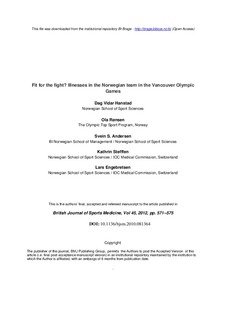Fit for the fight? Illnesses in the Norwegian team in the Vancouver Olympic Games
Journal article, Peer reviewed
Permanent lenke
http://hdl.handle.net/11250/93544Utgivelsesdato
2011Metadata
Vis full innførselSamlinger
- Scientific articles [2181]
Originalversjon
http://dx.doi.org/10.1136/bjsm.2010.081364Sammendrag
Background: The development of strategies to prevent illnesses before and during Olympic Games provides a basis for improved health and Olympic results.
Objective: (1) To document the efficacy of a prevention program on illness in a national Olympic team before and during the 2010 Vancouver Olympic Games (OWG), (2) to compare the illness incidence in the Norwegian team with Norwegian incidence data during the Turin 2006 OWG, and (3) with illness rates of other nations in the Vancouver OWG.
Methods: Information on prevention measures of illnesses in the Norwegian Olympic team was based on interviews with the Chief Medical Officer (CMO), the Chief Nutrition and Sport Psychology Officers, and on a review of CMO reports before and after the 2010 OWG. The prevalence data on illness were obtained from the daily reports on injuries and illness to the International Olympic Committee.
Results: The illness rate was 5.1% (5 of 99 athletes) compared to 17.3% (13 out of 75 athletes) in Turin (P=.008). A total of four athletes missed one competition during the Vancouver Games due to illness, compared to eight in Turin. The average illness rate for all nations in the Vancouver OWG was 7.2%.
Conclusions: Although no definite cause and effect link between the implementation of preventive measures and the prevalence of illness in the 2010 OWG could be established, the reduced illness rate compared to the 2006 OWG, and the low prevalence of illnesses compared to other nations in the Vancouver OWG suggest that the preparations were effective.
Beskrivelse
This is the authors' final and acceptet version, post refereeing, of the article. Publisher's version is available at http://bjsm.bmj.com/content/by/year
